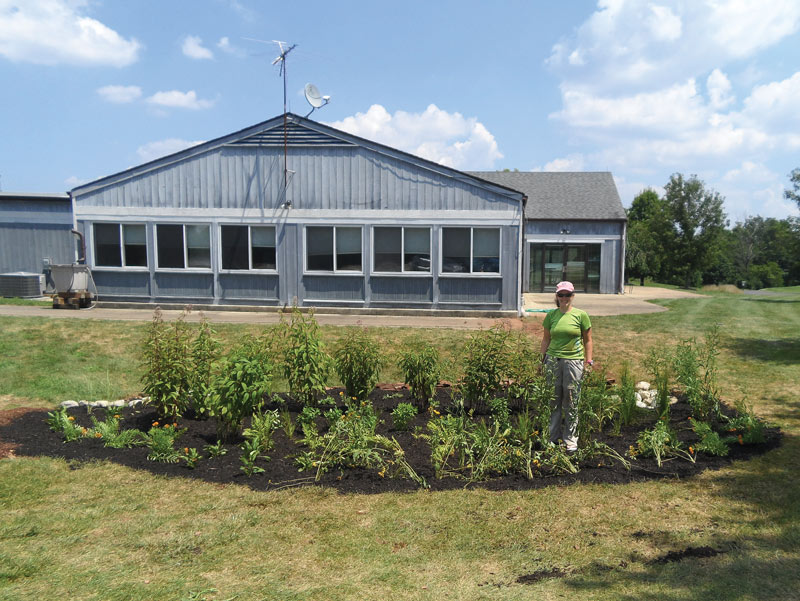
Wrangling runoff: The rain garden at Quail Brook Golf Course in Somerset, N.J. Pictured is Kathy Hale of the New Jersey Water Supply Authority, which worked with Quail Brook staff to create the garden. Photo courtesy of Darrell Marcinek
Golf courses have long been scrutinized for their water use and potential contamination of local waterways. There may never be a complete resolution to this matter, but perhaps easy, inexpensive rain gardens can help assuage a few of the pressures superintendents face, and help us better answer some of the questions we get asked.
A rain garden is a shallow depression into which plants, shrubs or trees are added for the purpose of capturing and filtering rainwater runoff from impervious areas (such as driveways, walkways, parking lots and roofs). Stormwater runoff can be a source of a slew of pollutants — salt, pesticides, fertilizers, petroleum products, harmful metals and others — that get washed off these hard or compacted surfaces during rain events. Without barriers such as rain gardens in place, stormwater typically flows directly into streams or storm drains, and in addition to introducing contaminants, it can cause erosion and flooding of waterways, and overflow sewer systems.
Along with providing localized flood control and filtering runoff to improve the water quality of nearby bodies of water, rain gardens also recharge groundwater reserves, and the resident plants encourage wildlife and biodiversity. Yet another benefit is that a rain garden can tie together a building with its surroundings in an attractive, environmentally advantageous way.
Determining a good location for a rain garden isn’t complicated. Perhaps you have an area at the lower end of your parking lot where water flows over a depressed curb, onto a grassy surface and then into a waterway or storm drain. Or maybe you have multiple downspouts that deposit water onto a grassy area adjacent to your clubhouse or maintenance building. Either of those locations would be ideal. Make sure whatever spot you pick is at least 20 feet away from any structure, as this buffer will prevent the water your rain garden gathers from exerting excess pressure on the building’s foundation.
Focus your plant selection on hydrophilic (water-loving) types as well as salt-tolerant options. Choose native plant species, and be mindful to avoid any plants on the invasive species list. A sandy loam or 6-2-2 mix is usually added in place of the soil extracted from the depression.
We established a rain garden at Quail Brook Golf Course in Somerset, N.J., in 2013, as part of a collaborative effort between the Somerset County Park Commission and the New Jersey Water Supply Authority (NJWSA). The course is involved in a number of voluntary environmental programs, and one of our objectives as part of the NJWSA’s River-Friendly Golf Course initiative was to install a rain garden.
We chose an area adjacent to one of our clubhouses where two downspouts emptied onto a concrete walkway that leads to a grassy area and then into a storm drain. We expanded one of the downspouts to be the rain garden’s water source, and put a rain barrel at the base of the other downspout, which allowed us to use the rooftop runoff to get the rain garden going and then continue to harvest water for the other plants in and around the clubhouse. The space was also perfect because the neighboring clubhouse includes a senior center, and its patrons enjoy the garden.
The Quail Brook rain garden is approximately 30 by 15 feet. Its depth at the centermost point is about 2 feet. We chose plants based on their ability to handle wet conditions as well as extended dry periods. Among these were black-eyed Susan, blue lobelia, butterfly weed, cinnamon fern, purple coneflower and red columbine. We situated the plants that are more hydrophilic toward the middle of the garden, where much of the water collects in torrential rain events. Once established, a rain garden waters and feeds itself, and it requires nothing more than mulching and weeding in terms of annual maintenance.
Anything we can do to protect the environment is welcomed in our industry, and water and water quality will remain hot topics for the foreseeable future. Local extension offices or universities can assist you in planning a rain garden at your facility, and they may even offer their services to help you construct it, as was our case with the NJWSA. My bosses and commissioners are big fans of our rain garden, and I think any green committee would be pleased with such a project too.
Darrell Marcinek, CGCS, has been the director of golf maintenance for the Somerset County Park Commission in New Jersey for 15 years. A 25-year GCSAA member, Darrell earned his bachelor’s degree in plant and soil science from the University of Massachusetts Amherst and his master’s degree in plant biology from Rutgers University-Newark. He and his wife, Gretchen, and their children, Josie and Claire, live in Hillsborough, N.J.